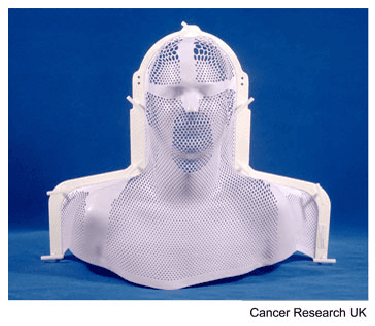Planning external radiotherapy
You might need to have a radiotherapy mask or mould made before you start treatment. They can also be called shells. They keep the treatment area of your body still each time you have your radiotherapy. This is so your treatment is as accurate as possible.
You might need a mask for radiotherapy of your head and neck. Or a mould for your arm or leg, or more rarely for your breast.
You can see through most types of masks or moulds, as they usually have lots of small holes. Your radiographers might make marks on them. They use the marks to accurately line up the radiotherapy machine for each treatment. It is important that you are in exactly the same position each time.
It takes between 10 to 45 minutes to make a mask or mould.
The mask is normally made directly against your skin. It's helpful to wear clothing that you can easily take off. You also need to take off any jewellery from that area.
Having a lot of facial hair can make it difficult to make a head and neck mask. The radiotherapy staff will advise you about any hair issues at your planning session.
A mould technician or radiographer makes the mask in the mould room of the radiotherapy department or during your CT planning scan.
The process of making a mask can vary slightly between hospitals. Most often they use a special kind of plastic heated in warm water or an oven so that it becomes soft and pliable. Your technician puts the plastic mesh on to your face so that it moulds to fit your face exactly. It feels a little like having a warm flannel put onto your face. You can still breathe easily, as the plastic has lots of holes in it.
After a few minutes the plastic mesh becomes hard. Your technician takes the mask off. It is then ready for use.

The video below shows what happens when you have your mesh mask made:
If you are having a mould for radiotherapy treatment to your arm or leg, you go through the same process as for a face mask.
Your technician or radiographer may also need to make a personalised leg or arm rest for you, as well as the mould.
For radiotherapy to the breast, you might need a breast mould to bring the breast up and keep it in the same position for each of your treatments.
Go to the cancer types section for information about treatment for your type of cancer
Last reviewed: 30 Oct 2023
Next review due: 30 Oct 2026
External radiotherapy uses radiotherapy machines to aim radiation beams at a cancer. This destroys the cancer cells. There are different types of external radiotherapy.
Your radiotherapy team carefully work out how much radiation you need to treat the cancer and exactly where you need it.
You usually have radiotherapy as an outpatient, which means travelling each day to the radiotherapy department at your nearest cancer centre or unit.
Search for the cancer type you want to find out about. Each section has detailed information about symptoms, diagnosis, treatment, research and coping with cancer.
Find out about cancer treatment with radiotherapy, including external radiotherapy, internal radiotherapy, side effects, radiotherapy for symptoms and follow up after treatment.

About Cancer generously supported by Dangoor Education since 2010. Learn more about Dangoor Education
What to ask your doctor about clinical trials.
Meet and chat to other cancer people affected by cancer.
Questions about cancer? Call freephone 0808 800 40 40 from 9 to 5 - Monday to Friday. Alternatively, you can email us.